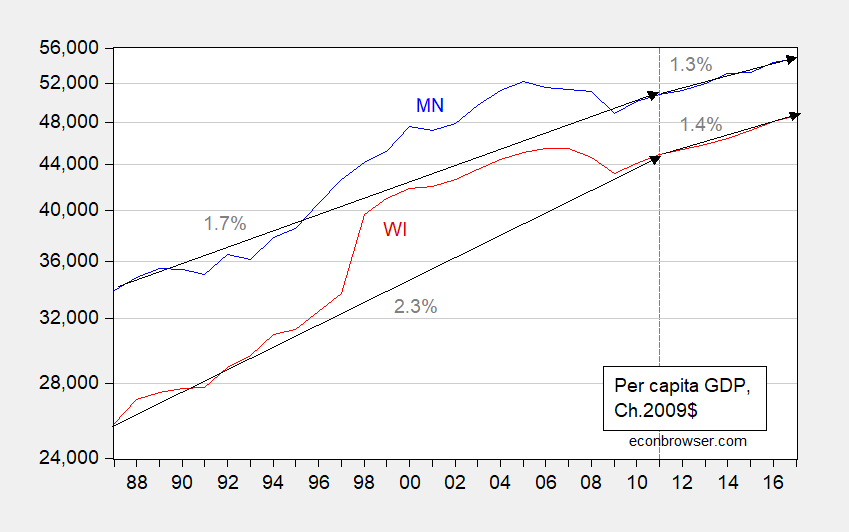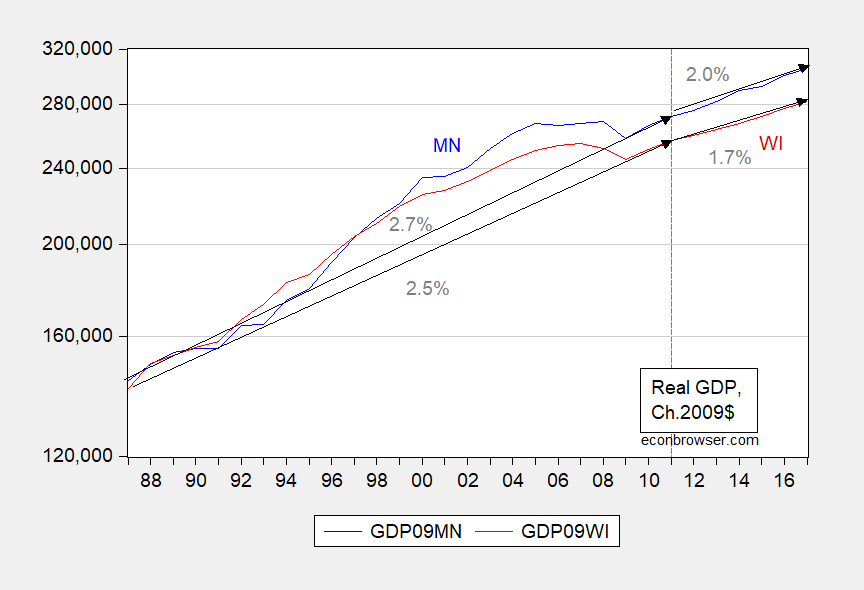Reader Ed Hanson accuses me of misleading people about the growth rate of per capita income in Minnesota and Wisconsin, by omitting results on trends in long samples, and focussing on short samples. Personally, I don’t recall plotting per capita income, but rather per capita income (which differs from GDP), but here for the interested reader is a graph of the relevant data, for the longest span readily available.

Figure 1: Minnesota GDP per capita (blue), Wisconsin GDP per capita (red), in Chained 2009$, NAICS. Pre-1997 data in 1997$, spliced using ratio in 1997. Arrows and figures in gray denote annual growth rates for 1988-2011, 2011-2017 respectively, calculated as first log differences. Source: BEA regional data, author’s calculation.
Note: the deceleration of growth from early to Walker/Dayton years was more marked in Wisconsin than Minnesota, that is 0.9 percentage points in Wisconsin vs. 0.4 in Minnesota.
So, sometimes I don’t respond because the point being made makes no sense; sometimes, I’m busy; sometimes, the error made in the comment is so obvious it doesn’t merit a response.
Addendum:
I did post on quarterly estimated GDP per capita here, using the longest available quarterly state GDP series.
Recalling that Governor Walker declared “Wisconsin open for business” as a means of reversing out-migration, it still seems to me real aggregate GDP is the relevant metric.

Figure 2: Minnesota GDP (blue), Wisconsin GDP (red), in millions Chained 2009$, NAICS. Pre-1997 data in 1997$, spliced using ratio in 1997. Arrows and figures in gray denote annual growth rates for 1988-2011, 2011-2017 respectively, calculated as first log differences. Source: BEA regional data, author’s calculation.
I think this only confirms the extent of the disaster in Wisconsin: (1) MN growth exceeds WI in Dayton/Walker years, and (2) MN deceleration is smaller than that of WI (0.7 ppts vs 0.8 ppts).
Interesting that Ed scolded CoRev noting you do not lie even if you allegedly misled. Of course there was nothing misleading about what you wrote.
I have to wonder if the Usual Suspects are in a 3-way race for being the most obnoxious person here with all these claims that we lied. I’m afraid Ed will only get the bronze but there is a serious race for gold v. silver between CoRev and PeakDishonesty.
It’s really difficult to make an accurate judgement of people’s character by looking at text on a screen. But we can “infer” some things, especially over a long timespan. I’ve gotten to the point I find “rtd” (I hesitate to mention it because I know for a fact he “gets off” on the mention of his ID name) the most inherently evil person in this blog. I think PeakIgnorance and CoRev are legitimately driven to embarrass themselves, as they have drunk the Kool-Aid, and truly believe in the right wing agenda. “rtd” on the other hand has no real stake in any of the politics—his ONE goal is to annoy, upset, or hurt whoever he is aiming his comment at.
In summation, “rtd” cares as much about partisan politics as Paul Ryan truly cares about a balanced federal budget. The partisan bickering is a tool for “rtd”, analogous to what a rusty shiv is to a prison inmate.
Komrad pgl, if we are in a race we’ve long lost to you!
I’m rubber you’re glue is a game most people grew out of. No wonder the kids in pre-K laugh at you!
that is 0.9 percentage points in Wisconsin vs. 0.4 in Minnesota.
Not following you. Isn’t it the other way around? That said, I don’t think I’d put too much emphasis on the simple linear trend model from 1988-2011. Maybe a LOESS model would be better, although the interpretation might be less clear for the layman.
2slugbaits: Sorry, mistake in graph (text correct). Now corrected graph.
Most people think this was Rep. Wilson insulting President Obama:
https://www.youtube.com/watch?v=qgce06Yw2ro
Actually this is recording of CoRev reacting to his kindergarten teacher saying 2 + 2 = 4.
We used to have a really great professor near where I live (not great as in “renowned” but great in his teaching and number crunching). He used to do econometrics for the metro area, and would be interviewed about the general shape of the state economy from time to time in the state’s major newspaper. He taught at a small 4-year state university, His name was Joseph T Johnson. He was a kind man, a great teacher, and used to be in the Air Force working inside AWACS planes. Then he just seemed to up and disappear from the University and the institute doing urban economics for the major city here. When I see these state data tabulated I often think of him and wonder where the hell he had run off to, as we have such little good economic metrics for this state. I hope wherever he is, he is healthy and happy, because I feel “we lost a good one” here in this miserable “red state”.
Maybe Gov. Walker’s record would look better if he spent more time studying actual economics and less time cavorting around with Russian spies exchanging access for sex. https://fox6now.com/2018/07/16/woman-arrested-charged-with-acting-as-russian-agent-in-us/
Maria Butina has red hair. She cannot be spying and exchanging sex for access. Sarah Huckabee Sanders told us that yesterday. And she never lies – right?!
Menzie
Yes per capita income is the graph I remember, again subject to my ability to remember. Why do you not just put a simple graph up on your post like FRED. Here is a link which I believe puts my point in a straight forward manner. First download:
https://fred.stlouisfed.org/series/WIPCPI
Then modify by editing graph by adding line MNCIPI found in the “EDIT GRAPH” section.
Pick the time span you wish to see. I chose 1970 to 2017 in the date boxes at the top of the graphs. The graph shows, in general, Minnesota’s increasing gap of per capita income over Wisconsin since at least 1970. It is not just since 2011 that this trend began.
In fact Menzie, why don’t you post the graph as described for all to see without having to leave EconBrowser?
Ed
Ed Hanson If you look at the year-over-year growth rates between the two states, I think you’ll find that overall (from 1970 thru 2010) neither state’s growth rate dominates the other. Wisconsin’s year-over-year growth rate exceeds Minnesota’s about half the time. Minnesota suffered a far bigger shock with the Great Recession, but beginning in 2010 it showed a big bounce back. Walker took over in 2011 and since then Minnesota has seen a higher growth rate in 2011, 2012, 2014 and 2015. Wisconsin saw larger growth rates in 2013, 2016 and 2017. But the main difference is that in the years in which Minnesota saw the larger growth rates the differences were much larger than when Wisconsin saw higher growth rates. In the four years when Minnesota had the higher growth rates, the average difference was 0.572 percentage points. In the three years when Wisconsin had the higher growth rate the average difference was only 0.208 percentage points. Put another way, when Minnesota outperformed Wisconsin it did so buy a relatively large margin. When Wisconsin outperformed Minnesota it did so only by a relatively small margin. Over time those differences add up.
Ed Hanson: I have provided a rejoinder, here. Thanks again for providing my students lots of examples of what not to do when looking at data. I am in your debt!
I understand the political differences between the author (Menzie) and the governor (Walker), but I fail to see that Wisconsin is a disaster in comparison with other Midwest or North Central states. It has a pretty solid economy (if not spectacular), it is less prone to recessions than many of its sister states, it has low unemployment, it has a lower crime rate than most (http://www.usa.com/rank/us–crime-index–state-rank.htm), and a relatively low poverty rate. It’s high school graduation rate is only slightly lower than Minnesota’s, but has lower rates of college degree attainment (probably reflecting it’s blue-collar/agricultural population) a lot like North Dakota.
Wisconsin has been, despite electing Scott Walker, a provincial, socialist-leaning, blue-collar, rust-belt, dairy state that neither excites nor disappoints. Its major city, Milwaukee, has had a socialist/progressive mayor for most of its history and manages a so-so ranking as a place to live (but not a “disaster”) https://realestate.usnews.com/places/wisconsin/milwaukee. I’d prefer Milwaukee over the true disaster, Detroit, any day.
Hyperbole in economics blogs?
Bruce Hall Wisconsin is not a disastrous place to live. At least not yet. I grew up in the Chicago area and enjoyed going up to Lake Geneva on weekends. In college I liked Old Style beer. And I never complained about having to go to Ft McCoy in the Tomah, WI area. And back when I was a twentysomething I came close to taking a job in Appleton. There’s a lot to like in Wisconsin. But Walker’s policies, if left unchecked, would eventually turn the state into Kansas. Now I have a lot of relatives in Kansas (on my mom’s side) and I spent a lot of summers there. Now the only time I go there is for funerals…and I wonder if the dead aren’t glad to leave the place. It’s godforsaken.
Check this out:
https://www.ssc.wisc.edu/~mchinn/
Gee – why would anyone who teaches economics at the Univ. of Wisconsin blog about the Wisconsin economy?